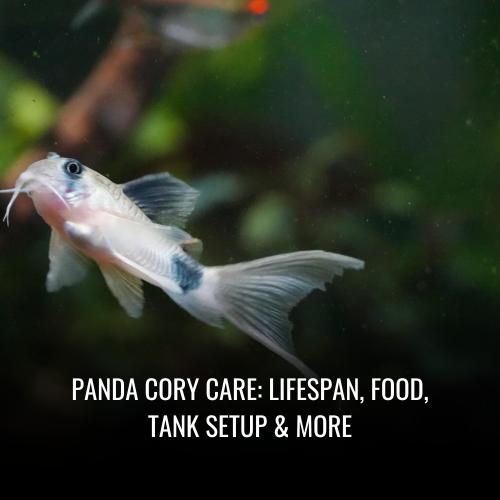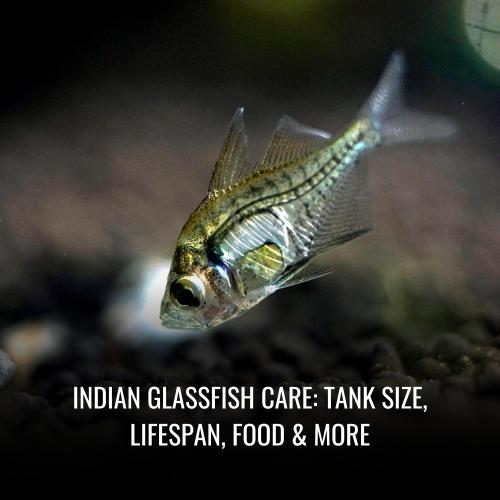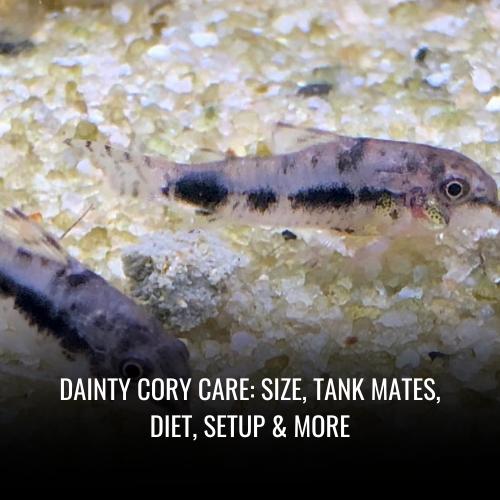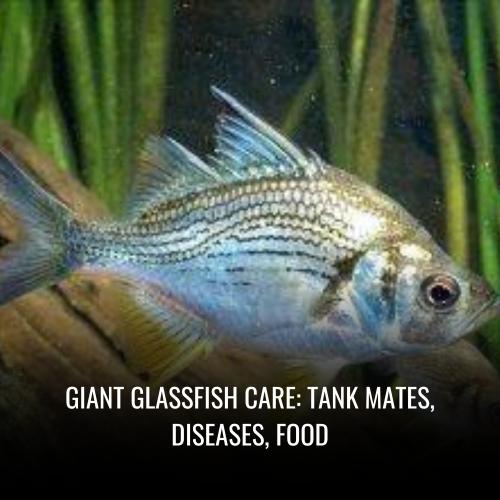Yellow tail tetra Care: Tank Mates, Size, Diet & Setup
This post contains affiliate links. As an Amazon Associate, we earn from qualifying purchases.
The Yellow Tail Tetra, also known as Astyanax aeneus, is a popular choice for aquarium enthusiasts due to its stunning appearance and peaceful nature. Originating from South America, this small, schooling fish is a great addition to community tanks and can easily coexist with a variety of other fish species.
One of the most striking features of the Yellow Tail Tetra is its bright and vibrant yellow tail, which beautifully contrasts with its silver body. This distinctive coloration adds a lively and cheerful touch to any aquarium, making them a standout choice for both beginner and experienced fish keepers.
| Attribute | Yellow Tail Tetra |
|---|---|
| Scientific name | Astyanax aeneus |
| Common name | Yellow Tail Tetra |
| Family | Characidae |
| Usual size in fish tanks | 2 inches |
| Recommended pH range | 6.0 – 7.5 |
| Recommended water hardness | 5 – 15 dGH |
| Recommended temperature | 72°F – 82°F (22°C – 28°C) |
| Reproduction | Egg scatterer |
| Origin | South America |
| Temperament to its own species | Peaceful |
| Temperament toward other fish species | Peaceful |
| Usual place in the tank | Middle to top |
| Lifespan | 3-5 years |
| Tank size requirement | 10 gallons minimum |
| Filtration system | Moderate to high filtration |
| Sexual dimorphism | Difficult to discern visually |
| Substrate cleaning | Regular vacuuming |
Scientific Name
The Yellow Tail Tetra is a striking freshwater fish scientifically recognized as Hemigrammopetersius caudalis, although it has been previously classified by names like Phenacogrammus caudalis within scientific literature. This diverse taxonomic history also includes designations such as Petersius caudalis and Petersius brumpti. The fish is a member of the Alestidae family, originating from the lush, flowing waters of the Congo River basin in Africa.
Visually, the Yellow Tail Tetra presents an attractive blue-hued body complemented by shimmering silver sides. However, its most notable feature is the pronounced bronzy-colored stripe that highlights its lateral line. Adding to its allure, this species is referred to by several common names, reflecting its vibrant coloration and geographic roots:
| Scientific Names | Common Names |
|---|---|
| Hemigrammopetersius caudalis | Yellow-Tailed Congo Tetra |
| Phenacogrammus caudalis | Yellowfin Congo Tetra |
| Petersius caudalis | Blue Congo Tetra |
| Petersius brumpti | (common name stays the same) |
These varying names emphasize the versatility and rich background of the Yellow Tail Tetra, making it a celebrated addition to any aquatic community.
Average Size
The diminutive Yellow Tail Tetra is recognized for its manageable size within the aquarium hobby. Adults typically reach between 1.5 to 2 inches (3.8 to 5 cm) in length, making them a perfect match for smaller aquascapes and community tanks.
The growth of these tetras can be quite rapid, with juveniles filling out to their maximum size within mere months under optimal conditions. Adequate nutrition and a stable, well-cared-for environment are crucial for the Yellow Tail Tetra to achieve its full size potential.
Interestingly, the species exhibits only subtle gender dimorphism, if any, in size. This means that both male and female Yellow Tail Tetras will commonly grow to be about the same size. Here’s a quick reference table for the Yellow Tail Tetra dimensions:
| Age | Size Range |
|---|---|
| Juvenile | Smaller than 1.5 inches (3.8 cm) |
| Adult | 1.5 to 2 inches (3.8 to 5 cm) |
Their petite stature is advantageous, as it allows these fish to thrive even in limited spaces where they can form dynamic shoals, adding movement and color to freshwater aquatic settings. An important note for aquarists is that, despite their small size, these tetras should have ample space and suitable aquatic vegetation to mimic their natural habitat and encourage healthy growth.
Lifespan
Yellow Tail Tetras are known for their longevity, with an average lifespan ranging from 5 to 6 years. Under ideal conditions, these vibrant fish can live even longer, with some individuals reaching the considerable age of 8 to 10 years, and in rare cases, up to 12 years. It’s noteworthy that females are typically ready to spawn by the age of 2 to 3, entering their reproductive prime.
During the warmer months, specifically from June to October, Yellow Tail Tetras enter their spawning season. Females are prolific spawners, capable of releasing a substantial number of eggs, with up to 150 being expelled per spawning event. This event is a sight to behold as around 100 eggs are commonly fertilized during each cycle.
Fertilization occurs externally in the following steps:
- Females disperse eggs into the water column.
- Males release sperm over the eggs to fertilize them.
The meticulous care taken by aquarists to mimic their natural breeding conditions can significantly impact both the fecundity of the Yellow Tail Tetras and their overall lifespan, ensuring a thriving environment for generations to come.
Natural Habitat
The Yellow Tailed Congo Tetra flourishes in the aquatic diversity of the Boma and Lower Congo Rivers in the Democratic Republic of Congo. These fish are adept at navigating the murky streams and calm marshes that characterize their environment. The water here is mildly acidic, a condition that these Tetras are well-acclimated to.
In these waters, tall aquatic vegetation towers, creating a submerged forest of tranquility for the tetras to call home. They find refuge among the fine sand, silt, and nutrient-rich mud—all under the protective umbrella provided by the forest canopy. This unique blend of water conditions, vegetation, and soft substrates forms a harmonious ecosystem ideal for the Yellow Tailed Congo Tetra’s survival.
Despite the peacefulness of their preferred habitats, these Tetras also inhabit areas with rocky reefs, kelp beds, and even around offshore islands. Such regions expose them to a different set of predators including great white sharks, California sea lions, and their most unpredictable threat—humans. However, their main habitat remains a serene haven, a stark contrast to these more perilous zones.
Appearance
The Yellow Tail Tetra, known scientifically as Phenacogrammus caudalis, exhibits an elegant body structure that demands attention in any freshwater aquarium setup. These small, slender fish showcase a silvery-white body that glistens in aquatic environments, accentuated by a prominent lateral line. As the Tetras age, their most notable feature—a vibrant yellow caudal fin—deepens in intensity, projecting a stunning contrast against their lighter body coloration.
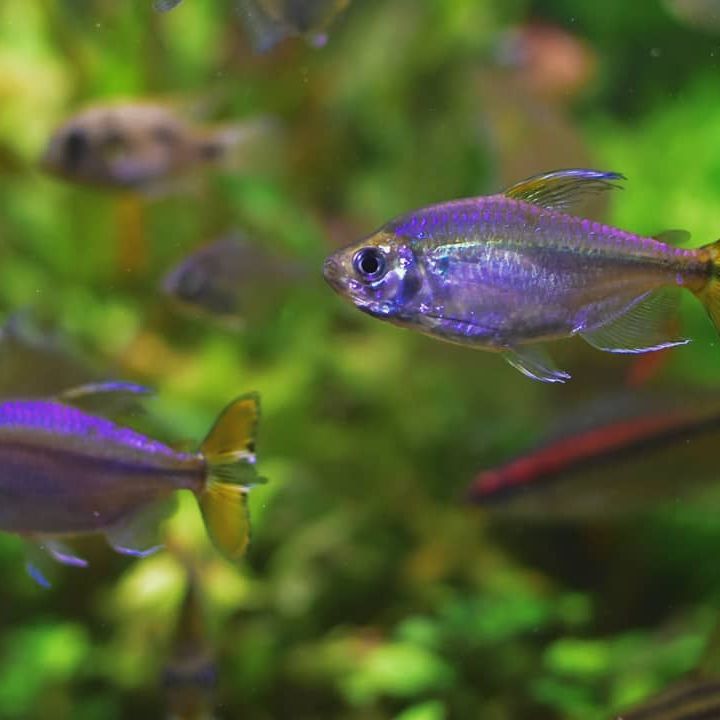
A remarkable aspect of their appearance is the iridescence of their scales. When the light hits just right, the scales emit a captivating shimmer, enchanting observers with a sparkling display. Yellow Tail Tetras have well-proportioned, elongated dorsal and anal fins, while their pelvic fins are beautifully translucent, enhancing their natural charm.
Quick and refined in their movements, this species boasts a streamlined shape which aids in their agility within the water column. The cohesive appearance of their sparkling scales and dynamic fins gives the Yellow Tail Tetras a dignified and mesmerizing presence wherever they swim.
| Body Color | Silvery-White with Iridescent Scales |
|---|---|
| Prominent Feature | Bright Yellow Caudal Fin |
| Fins | Elongated Dorsal and Anal, Translucent Pelvic |
| Maturity Highlight | Intensified Yellow Tail with Age |
Behavior & Temperament
The Yellow Tail Tetra, denoted scientifically as Alestopetersius caudalis or Phenacogrammus caudalis, presents an interesting mix of social and skittish behavior. Despite their somewhat shy nature, they are an active shoaling species that demonstrate a strong preference for group living. In the aquarium, these fish best showcase their social behavior when free from stress, requiring a serene habitat with spacious swimming areas that enable their playful and exploratory character. This species reveals a different side of their personality when in a well-maintained tank with compatible companions, exuding confidence and providing engaging interactions for aquarists.
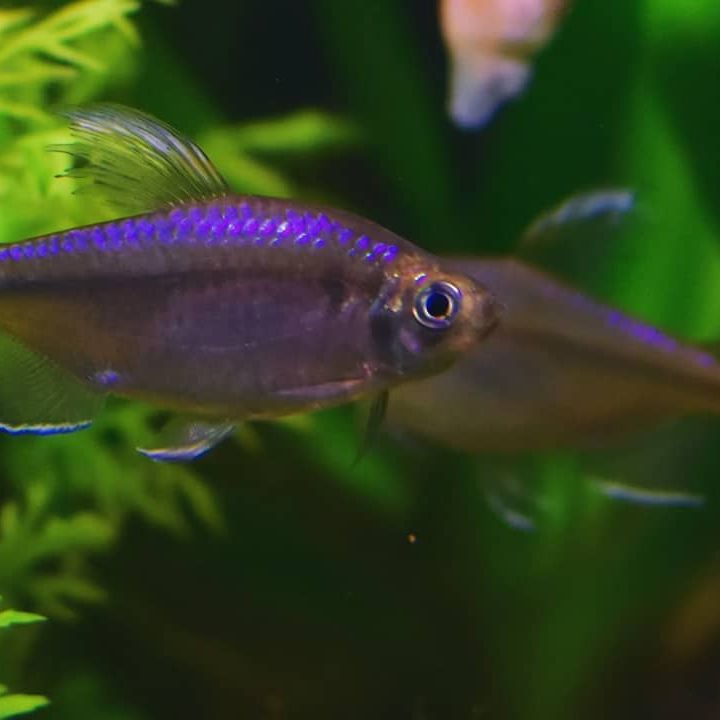
Are Yellow Tail Tetra Fin Nippers?
Yellow Tail Tetras are known for their peaceful coexistence in the aquarium setting and are generally not seen as fin nippers. Tailored for community tanks, their small mouths and passive demeanor prevent them from harassing other inhabitants, making them excellent neighbors to a variety of non-aggressive fishes, including those with longer fins. To foster harmony in your aquarium, it is suggested to keep these tetras in a school of six or more, as it can effectively discourage any rare nipping behavior.
Are Yellow Tail Tetra Aggressive To Each Other & Other Fish?
In terms of aggression, Yellow Tail Tetras do not pose significant problems. Although minor territorial disputes can occur, particularly during the spawning period, these fish are usually not aggressive or dominant over others. Maintaining a school of 6 to 8 specimens is beneficial, not only for the reduction of intraspecific aggression but also to allow these fish to engage in their natural schooling instincts. Larger tank mates that are peaceful by nature can reside amicably with Yellow Tail Tetras, provided the aquarium is sizeable and well-structured with hideouts and space to explore.
Are Yellow Tail Tetra Friendly To Each Other & Other Fish?
Indeed, Yellow Tail Tetras are friendly both among their kind and with other small, peaceable fish. To enhance this friendly disposition, it is recommended to keep them in groups of no fewer than six individuals. The group dynamic minimizes stress and promotes their gregarious inclinations. Their compatibility extends to larger, calm invertebrates, although caution is advised with dwarf shrimp, which may fall prey to these tetras due to their diminutive size. However, in the vast waters of the Congo River basin from which they originate, Yellow Tail Tetras demonstrate a peaceful rapport with other species.
Are Yellow Tail Tetras Schooling Fish?
Yellow Tail Tetras epitomize schooling behavior and benefit significantly from living in groups. It’s advised to keep them in groups of at least 6 to 8 for optimum health and vibrant coloration. Within a school, these tetras feel more secure and are less prone to stress while contributing to an engaging and appealing aquarium display. Schooling also aids in establishing a hierarchy, which reduces encounters of aggression and supports a peaceful coexistence.
Can You Have Just One Yellow Tail Tetra In The Tank?
Yellow Tail Tetras are inherently social and depend on the presence of their kind for a sense of security and well-being. Keeping a solitary Yellow Tail Tetra is not recommended as it can lead to anxiety and aberrant behaviors. In nature, these fish rely on the safety of numbers when navigating their environment, exhibiting a strong schooling instinct. A lone tetra might be incessantly reclusive and less inclined to display a full spectrum of natural behaviors.
Do Yellow Tail Tetras Need To Be In Groups?
A solitary life for a Yellow Tail Tetra goes against their fundamental social instincts. These tetras genuinely need to be in groups to experience a sense of safety and exhibit their characteristic vivacious behavior. A group setting helps temper individual aggression and contributes to the well-being of the school, making them more audacious and active in the aquarium. In addition, the grouping emulates their natural lifestyle, thus mitigating stress and fostering healthier living conditions.
| Characteristic | Details |
|---|---|
| Social Behavior | Thrive in groups, reducing stress and aggression |
| Compatibility | Peaceful with other non-aggressive fish and larger invertebrates |
| Schooling | Best kept in groups of 6-8 |
| Lone Individuals | Not recommended, prone to stress and behavioral issues |
| Aquarium Setup | Requires ample space and hiding spots for best health |
Food & Diet
Yellow Tail Tetras, scientifically named Alestopetersius caudalis, display a diverse and omnivorous diet both in their natural Congo River basin habitat and within home aquariums. Their diet consists of small crustaceans, insects, fallen fruits, and even some algae, exhibiting their versatile foraging behavior. This varied diet contributes to their vibrant coloration and overall vitality.
In captivity, it’s important to mirror their natural nutritional intake as closely as possible to maintain good health and coloration. This includes offering high-quality dried flakes and pellets, designed for omnivorous fish, that often contain a mix of both animal and plant-based nutrients. However, to ensure a balanced diet and meet their nutritional requirements, supplementing with live, frozen, or freeze-dried foods such as Mysis shrimp, bloodworms, brine shrimp, and mosquito larvae is recommended. Including offerings such as daphnia and Moina can significantly enhance their well-being.
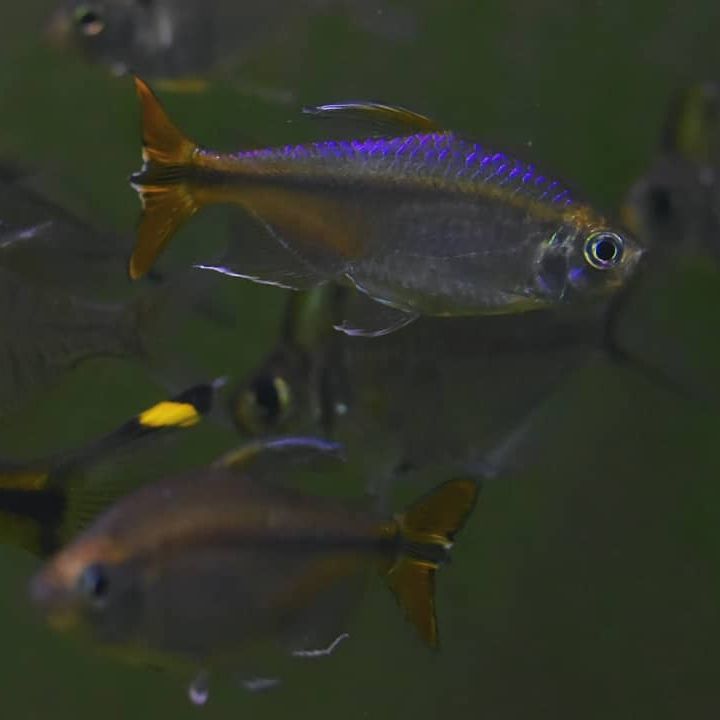
While they accept most conventional aquarium foods, and can adapt to eagerly consume high-quality dried flakes and granules, enhancing their diet with a variety of live and frozen foods can bring out the best in these fishes. Furthermore, incorporating some plant or algal content supports their digestive health and mimics their natural feeding habits. Yellow Tail Tetras are adaptable to a range of water parameters but tend to thrive in softer, acidic water where their natural food sources like algae are abundant.
Adult male Yellow Tail Tetras usually display more intense coloration, which can be further intensified by a varied and rich diet. While these fish don’t exhibit parental care and are egg scatterers, juvenile tetras start out eating microscopic foods and graduate to larger live foods, like daphnia and bloodworms, as they grow.
| Dietary Component | Benefits | Examples |
|---|---|---|
| Dried Flakes/Pellets | Convenient, balanced nutrition | High-quality omnivorous fish formulas |
| Live Foods | Enhance coloration, natural feeding | Mysis shrimp, bloodworms |
| Frozen Foods | Rich in protein, easy storage | Brine shrimp, mosquito larvae |
| Plant/Algal Matter | Digestive health, mimic wild diet | Algal wafers, spirulina flakes |
| Fruits/Insects | Varied diet, health, vitality | Fallen fruit, small insects in nature |
Does Yellow Tail Tetra Eat Algae?
Yellow Tail Tetras can consume algae as part of their omnivorous diet, especially when living in the wild where a variety of food sources are available. In the aquarium, their diet should include good quality dried flakes and granules with some plant or algal content to satisfy their nutritional needs reminiscent of their natural feeding habits. Softer water with a pH leaning towards the acidic side is preferred by these fish and is also favorable for algae growth, which Yellow Tail Tetras may nibble on.
Do Yellow Tail Tetra Eat Shrimp?
In their native habitats, Yellow Tail Tetras feed on crustaceans, so it is no surprise that they would also eat small shrimp and shrimp larvae in an aquarium setting. However, while they include shrimp in their diet, it is not the main component, so supplementing with high-quality dried foods that include plant or algal content is still crucial to ensure a balanced diet.
Do Yellow Tail Tetra Eat Bloodworms?
Bloodworms are a popular food choice for many freshwater fish, including Yellow Tail Tetras. These live or frozen larvae provide a rich source of protein and are readily eaten by tetras. Serving bloodworms as part of their varied diet contributes to the fishes’ overall health, vitality, and supports the magnificent coloration of the males. However, while bloodworms are beneficial, they should be given as a supplement to a diet of flakes, pellets, and other omnivorous foods to ensure a well-rounded diet.
Do Yellow Tail Tetra Eat Mosquito Larvae?
Mosquito larvae make an excellent addition to the diet of Yellow Tail Tetras. These protein-rich larvae reflect the natural feeding habits of these fish in the wild and contribute essential nutrients to their diet. Offering mosquito larvae will not only support their health and growth but also enhances their foraging behavior, promoting natural instincts. Such live food provides enrichment and is a valuable dietary supplement for mimicking the natural variety of their intake in the wild.
Do Yellow Tail Tetra Eat Planaria?
While planaria are not a common dietary component for Yellow Tail Tetras, they might occasionally consume small ones in the aquarium. However, planaria can be an indicator of overfeeding or poor tank maintenance, so their presence should be addressed rather than relied upon as a food source.
Do Yellow Tail Tetra Eat Plants?
As part of their omnivorous nature, Yellow Tail Tetras may occasionally graze on plant matter. While they do not primarily subsist on plants, including some form of plant-based nutrition in their diet can be beneficial. Good quality dried food that contains plant or algal ingredients can help fulfill their nutritional profile, alongside the varied animal-based foods they are offered.
Sexing: Male vs Female
Determining the gender of Yellow Tail Tetras can be a nuanced task. Males typically stand out with enhanced coloration, making them slightly easier to distinguish. A clear indication of a male is the white-colored edges on their fins, a feature females lack. Additionally, males possess a black elongated section in the middle of their caudal (tail) fin, which is notably absent in females.
Size is another physical factor; females tend to be smaller. Moreover, a keen observation of behavior in a group setting may reveal dominant traits and vivid coloration more prominent in males.
| Gender | Coloration | Fin Edges | Caudal Fin | Size |
|---|---|---|---|---|
| Male | Vibrant | White | Black extended middle section | Larger |
| Female | Less vibrant | None | Uniform | Smaller |
These characteristics are clues for aquarists to identify male and female Yellow Tail Tetras. However, subtle differences may require a careful and patient observation to accurately sex these active and colorful fish.
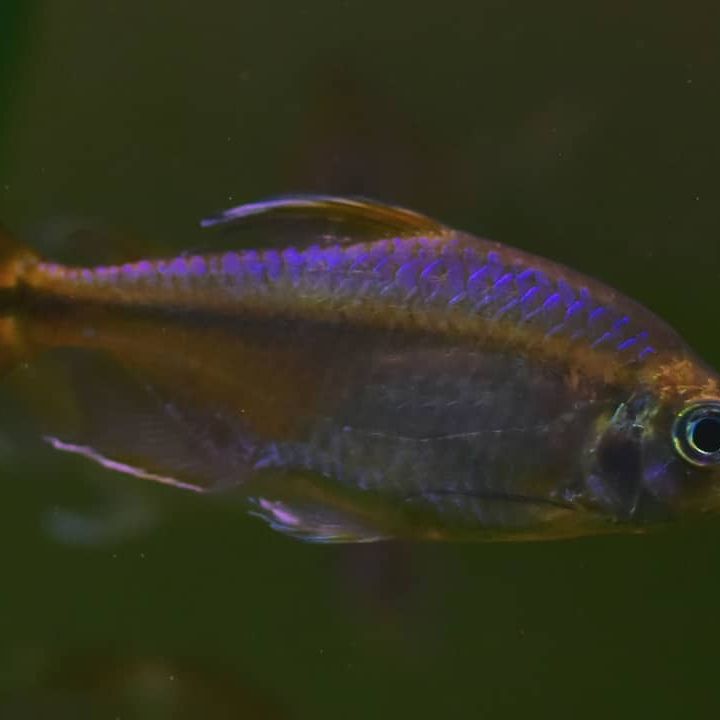
Yellow tail tetra Tank Mates
Yellow Tail Tetras are known for their peaceful nature, making them excellent companions for a variety of fish in a community aquarium. They are an ideal match for peaceful larger fish such as angelfish, severums, and chocolate cichlids, coexisting without conflict due to their amicable behavior and comparable size.
These tetras are equally at home with smaller species, including Apistogramma and Pelvicachromis, showcasing their versatility and compatibility with both larger and smaller tank mates. Their adaptability extends to water conditions as well. Yellow Tail Tetras thrive in darker, tannin-stained water reminiscent of their natural habitats. However, they adjust just as effortlessly to well-lit tanks, accommodating the preferences of different aquatic species and various aquarium setups.
Although dwarf shrimp may not be suitable companions because of the tetras’ size, other larger, peaceful invertebrates can share a tank safely with Yellow Tail Tetras. These fish tolerate a broad pH range, further widening their compatibility with other species that have specific water needs.
Tank Mate Compatibility:
| Species Type | Compatibility |
|---|---|
| Larger Fish | Highly Compatible |
| Smaller Fish | Compatible |
| Dwarf Shrimp | Not Suitable |
| Large Invertebrates | Compatible |
Remember to avoid pairing them with tiny invertebrates like dwarf shrimp, as they might be seen as potential snacks. The inclusion of ample aquatic vegetation can provide hiding spots and enhance the natural ecosystem for all inhabitants.
Aquarium Setup
Setting up an aquarium for Yellow Tail Tetras demands attention to their specific needs and preferences to ensure a healthy and stimulating environment. These lively shoaling fish originate from the rivers of South America and are active swimmers, so providing a well-planted aquarium with plenty of space is crucial for their well-being.
To cater to their social nature, the aquarium should offer ample space for swimming, alongside aquatic vegetation that provides adequate hiding spots. These decor elements not only serve the functional purpose of mimicking their natural habitats but also enhance the aesthetic appeal of the tank.
Ideal Tank Size
When it comes to housing Yellow Tail Tetras, space is a priority. These fish flourish in groups and require a tank that grants them enough room to exhibit their shoaling behavior.
| Group Size | Minimum Tank Size |
|---|---|
| 6 Yellow Tail Tetras | 15 gallons |
| With additional fish | 20 gallons or more |
A school of 6 or more Yellow Tail Tetras should be comfortably accommodated in at least a 15-gallon tank. For a more dynamic environment and to minimize territorial aggression, a 20-gallon tank or larger is even better. The ideal tank dimensions would include a minimum length of 24 inches, providing optimal horizontal swimming space for these active fish.
Ideal Water Parameters
For Yellow Tail Tetras, water quality is not just about clarity—it’s about creating an environment that closely resembles their natural habitat. The following parameters are key:
| Parameter | Ideal Range |
|---|---|
| pH Level | 6.5 to 8.0 |
| General Hardness (GH) | 10 to 20 |
| Total Dissolved Solids (TDS) | 36 to 268 |
| Temperature | 72 to 79°F (22 to 26°C) |
These fish exhibit the best health and vitality when the water’s pH level is slightly acidic to slightly alkaline. Ensuring the water hardness is within the indicated range facilitates their biological functions. Total Dissolved Solids (TDS) levels should mimic their natural aquatic environments, and a consistent temperature keeps the fish active and vibrant.
Filtration
Yellow Tail Tetras are very sensitive to water conditions, making efficient filtration non-negotiable. A combination of filtration methods—mechanical, biological, and chemical—is advisable to maintain water quality and support the delicate ecosystem within the aquarium.
For mechanical and biological filtration, canister filters or high-output power filters are suitable choices. Filter media such as sponges, ceramic rings, and activated carbon contribute to a comprehensive filtration system, capturing debris and processing ammonia, nitrites, and nitrates. It is vital to regularly check and clean the filter to ensure it continues working efficiently.
Lighting
Originating from the luminous water bodies of South America, Yellow Tail Tetras are accustomed to moderate lighting conditions that emulate the dappled sunlight of their habitat.
| Lighting Type | Effect |
|---|---|
| Moderate LED or Fluorescent Lights | Encourages natural behaviors |
| Natural Day-Night Cycle | Regulates behavior, reduces stress |
| Shaded Areas & Plants | Offers refuge, creates natural environment |
The use of LED or fluorescent lighting provides an ideal balance. Be cautious of over-illumination, as it may stress the fish and provoke health problems. Simulating a natural day-night cycle using timers can further stabilize the fish’s behavior, while vegetation offers sheltered spots for them to retreat from the light.
Common Possible Diseases & Prevention
Yellow Tail Tetras, like many species of fish, are prone to certain diseases such as ich and fin rot. These ailments are often attributed to stress and poor water quality. To safeguard your vibrant fish, consider the following preventative measures:
- Maintain pristine water conditions: Regular water changes and diligent tank cleaning suppress disease-causing pathogens.
- Quarantine new arrivals: Keep newly acquired fish isolated initially to reduce the risk of introducing diseases to established tank mates.
- Diet and density: Ensure a nutritious diet and avoid overstocking to alleviate stress and promote a robust immune system.
- Regular observation: Monitor your Yellow Tail Tetras for abnormal behavior or changes in appearance, key indicators of emerging health issues.
Implementing these strategies can dramatically lower the chances of disease outbreaks within your aquarium.
| Preventive Strategy | Benefit |
|---|---|
| Water Changes | Reduces pathogen load |
| Quarantine | Prevents disease spread |
| Balanced Diet | Strengthens immunity |
| Observation | Early detection and treatment of issues |
| Appropriate Stocking | Prevents stress and aggression among fish |
Proactive care will help maintain the health and vibrancy of your Yellow Tail Tetras, ensuring a thriving aquatic community.
Breeding Yellow tail tetra In Aquarium
Breeding Yellow Tail Tetras can be an exciting venture for aquarium enthusiasts. These egg layers require a specific environment to reproduce, necessitating the setup of a separate breeding tank. The tank should mimic their natural conditions: soft, acidic water with a pH between 6.0 and 7.0, and temperatures kept between 72° and 79° F (22° – 26° C) to facilitate spawning.
A successful breeding environment for these fish includes:
- Ample space: Ensuring the fish have enough room for the breeding process.
- Dense vegetation: Plants serve as a refuge for fry and a place for eggs to adhere.
- Adjusted water conditions: Creating a suitable pH and temperature to encourage spawning.
Upon preparing the tank, female Yellow Tail Tetras will scatter their sticky eggs amidst fine-leaved plants or the substrate. Post-spawning, it is crucial to remove adult fish to safeguard the eggs from becoming their next meal. Hatchlings thrive on infusoria or specific liquid fry food, and as they grow, they should transition to baby brine shrimp or finely ground fry food.
| Stage | Diet for Fry |
|---|---|
| Initial | Infusoria, liquid fry food |
| After Growth | Baby brine shrimp, powdered food |
Following these guidelines will enhance your likelihood of successfully breeding Yellow Tail Tetras in your aquarium.
Are Yellow tail tetra Easy To Keep?
Yellow Tail Tetras are widely famed for their adaptability and resilience, rendering them an excellent choice for both neophytes and seasoned aquarists. These small, vibrant fish boast the ability to thrive under a variety of water conditions, with a forgiving pH range of 6.0-7.5, soft to moderately hard water, and temperatures spanning from 70-82°F. Their omnivorous diet only adds to their ease of care—not only do they readily accept flakes, pellets, live, and frozen foods, but their dietary flexibility facilitates effortless feeding routines.
Operating on a peaceful and social temperament, Yellow Tail Tetras get along with a broad spectrum of tank mates. Be it schooling fish of similar size, dwarf cichlids, or the gentle giants from West Africa, these tetras are the proverbial glue in the community tank tapestry. Their undemanding nature and lack of specialized care requirements make them a highly convenient choice for maintaining a harmonious aquatic community without the imposition of extensive or meticulous attention.
Are Yellow tail tetra Sensitive To Water Changes?
Despite their hearty reputation, Yellow Tail Tetras maintain a sensitivity towards sudden water parameter shifts. Abrupt changes in temperature, pH, or hardness could stress these small characins, leading to health issues or even increased susceptibility to disease. Significant water adjustments can disrupt the delicate equilibrium in their aquatic environment—this disturbance in balance may, in turn, precipitate stress and afflict the tetras with various health complications.
For this reason, careful acclimatization to new water conditions is of paramount importance to sidestep undue stress and allow the fish’s physiology to adjust appropriately. Consistency in water quality is the linchpin for the health and longevity of Yellow Tail Tetras. Aquarium owners should implement routine water testing and make water changes gradually to preserve the optimal environment for their finned charges.
Are Yellow tail tetra Sensitive To Ammonia?
A well-managed habitat with minimal ammonia presence is crucial for the well-being of Yellow Tail Congo Tetras, as elevated levels can incite stress, breathing difficulties, and poor health outcomes. Ammonia spikes, notably perilous during an aquarium’s nitrification process, necessitate the prompt establishment of beneficial bacteria that degrades ammonia, providing a safeguard for the fishes’ health.
It is essential to monitor ammonia concentrations diligently, utilizing regular water testing and performing partial water changes as needed. Ammonia poisoning is a legitimate concern, with visible manifestations including acute gill damage, lethargy, and surface gasping by affected tetras. Prompt corrective measures are vital when faced with such situations to reverse the conditions impacting the survival of these sensitive fish.
Are Yellow tail tetra Sensitive To Copper?
Yellow Tail Tetras, like many fish species, exhibit a marked sensitivity to copper in their aquatic environment. Copper, even at minimal concentrations, is toxic and can disrupt vital cellular processes. The repercussions on cellular respiration and enzyme activity can lead to respiratory distress and severe organ damage. Trace copper levels pose significant health risks, making it imperative to avoid copper-based medications or equipment that can leach the metal into the tank water.
Copper toxicity can also impair the nervous system, resulting in alarming symptoms such as erratic swimming or loss of equilibrium. Tetra owners must carefully regulate copper levels, often resorting to water testing kits specifically designed to detect and measure this element. Ensuring the health and longevity of Yellow Tail Tetras demands a steadfast commitment to copper-free water conditions in their habitat.


